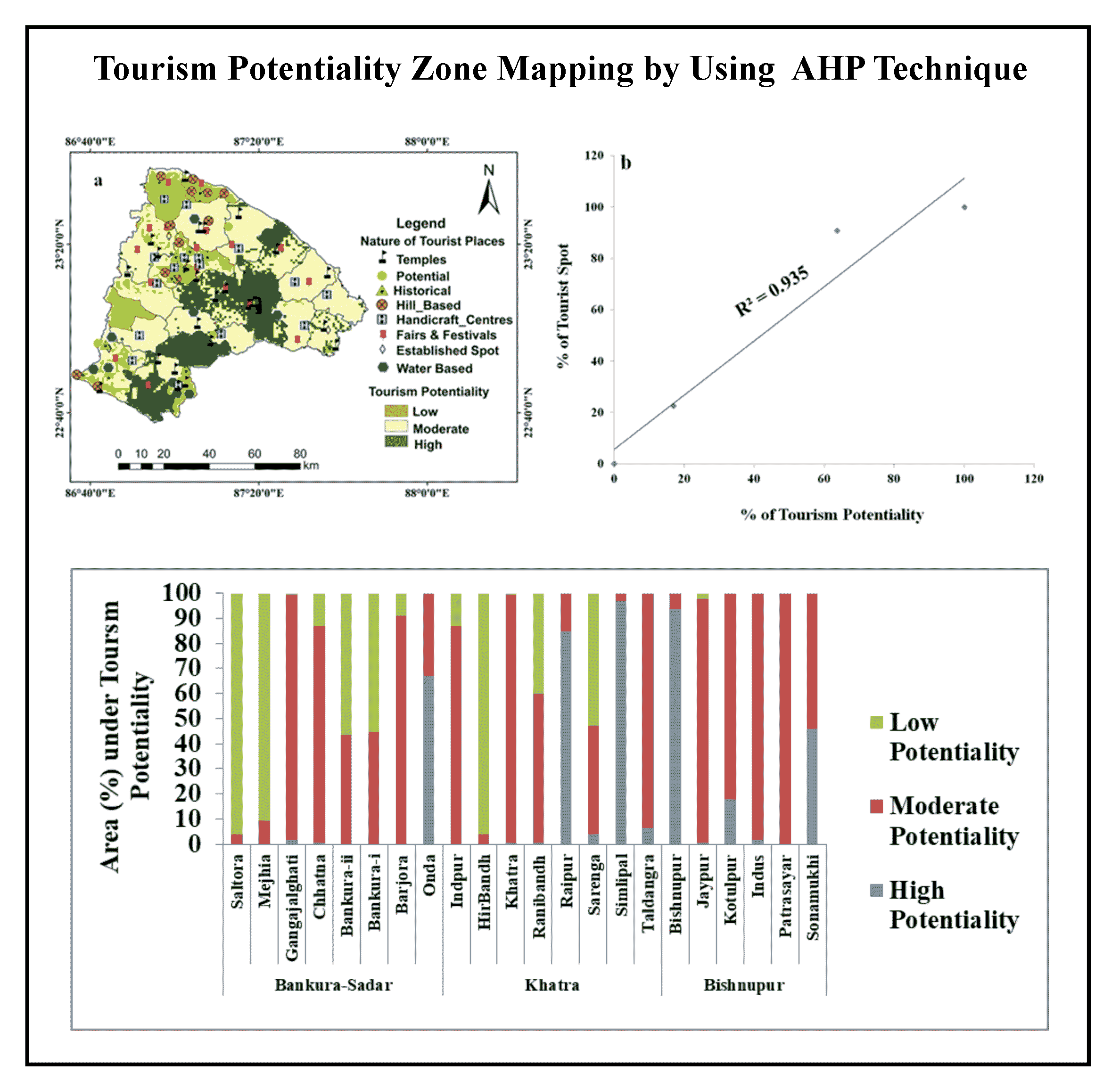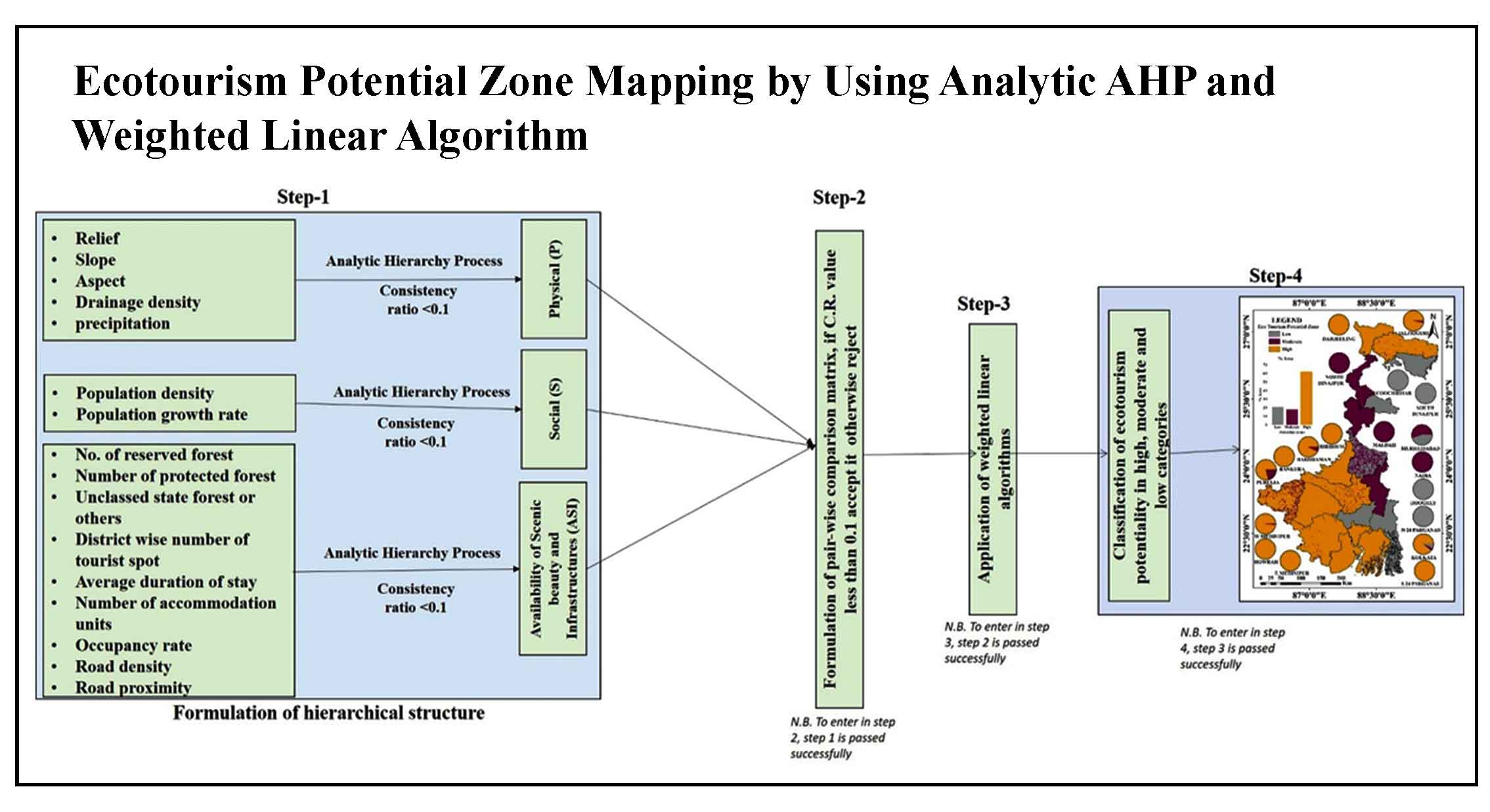Article Title :
Tourism Potentiality Zone Mapping by Using the AHP Technique: A Study on Bankura District, West Bengal, India 
6 (2022)
58-85
Analytic Hierarchy Process , AHP , Sustainability Indicators , Tourism Potentiality Zones , TPZ , Weighted overlay analysis


Tourism is a multidimensional sector having significant contributions to sustainable development, economic upliftment, and social benefits. Although the Bankura is full of tourism potential, but its’ tourism potentiality has not been properly used. This study is designed to identify the tourism potential zones of the Bankura district using a 5-steps integrated methodology, which includes the preparation of the thematic layers (Eight parameters and thirty-four indicators) (Step-1); creation of matrices for pair-wise comparisons (Step-2); classification of the raster maps (Step-3); use of the weighted sum method to get the composite variables (Step-4) and classification of tourism potential map using the natural breaks (Step-5). This study has selected eight parameters, which are the Tourist Intensity Measure (TIM), Climate (C), Physical (P), Social (S), Economy (E), Environmental Quality (EQ), Amenities (AN), and Diversity in Local Art and Crafts (LAC′). Approximately, 23.33% area is identified with a high tourism potentiality, 58.74% area is observed under the moderate tourism potentiality, and 17.92% area is recognized as a low tourism potentiality. Efficiency testing of the tourism potentiality map indicates high precision utilizing the considerably high R-square value (0.94). The study uses an exceptional methodological framework applicable in any region.

Tourism Potential Zone is mapped using a 5 Step integrated AHP method.
This research has selected eight parameters, which are the Tourist Intensity Measure (TIM), Climate (C), Physical (P), Social (S), Economy (E), Environmental Quality (EQ), Amenities (AN), and Diversity in Local Art and Crafts (LAC′).
Approximately, 23.33% area is identified with a high tourism potentiality, 58.74% area is observed under the moderate tourism potentiality, and 17.92% area is recognized as a low tourism potentiality.
Efficiency testing of the tourism potentiality map indicates high precision utilizing the considerably high R-square value (0.94).
Asfairsh, A. G. and Kumar, S., 2019. Assessing progress of tourism sustainability: Developing and validating sustainability indicators. Tourism Management, 71, 67-83.
Ashley, C. and Roe, D., 2001. Pro-poor tourism strategies: Making tourism work for the poor: A review of experience, 1, Iied.
Beeco, J. A. and Brown, G., 2013. Integrating space, spatial tools, and spatial analysis into the human dimensions of parks and outdoor recreation. Applied Geography, 38,
Census of India 2011. Accessed 20 May 2020.
Chatterjee, K., 2020. Media and Nation Building in Twentieth-Century India: Life and Times of Ramananda Chatterjee. Taylor and Francis.
Cohen, S. A., Prayag, G. and Moital, M., 2013. Consumer behaviour in tourism: Concepts, influences and opportunities. Current Issues in Tourism, 17(10), 872-909.
Hazra, K., 1999. From Ganjifa to Dashavatar, Paschim Rarh Bibidha Prasango, 10-13.
Mauerhofer, V., 2013. Social capital, social capacity and social carrying capacity: Perspectives for the social basics within environmental sustainability. Futures, 53, 63-73.
Newsome, D., Moore, S. A. and Dowling, R. K.., 2012. Natural area tourism: Ecology, impacts and management. Channel view publications.
Pan, S., 2011. Tourism and rural development: A case study in Bankura District, West Bengal. Doctoral Dissertation guided by Dr. Premangsu Chakraborty. Available at shodhganga.ac.in. (Unpublished Thesis).
Phillips, W., Indar, D. and Thorne, E., 2017. An analysis of the art and craft sector and its potential for sustainable tourism development in the Caribbean.
Saaty, T. L., 1980. The analytic hierarchy process. McGraw-Hill, New York.
Sánchez-Rivero, M. and Cárdenas-García, P. J., 2014. Population characteristics and the impact of tourism on economic development. Tourism Geographies, 16(4), 615-635.
Santos, G. E. de O., Ramos, V. and Rey-Maquieira, J., 2014. Length of stay at multiple destinations of tourism trips in Brazil. Journal of Travel Research, 54(6), 788-800.
Shaker, R. R., 2018. A mega-index for the Americas and its underlying sustainable development correlations. Ecological Indicators, 89, 466-479.
Tourism Final Year Report of 2014-15 on West Bengal.1-504.
Vaidya, O. S. and Kumar, S., 2006. Analytic hierarchy process: An overview of applications. European Journal of Operational Research, 169(1), 1-29.






